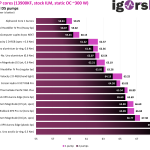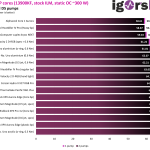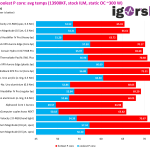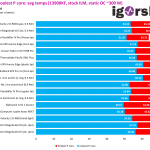Results Intel LGA 1700 – Core i9 13900KF
Let’s finally get to the results. Water blocks are listed here several times if they were tested in several variants, e.g. if the type of assembly has a major influence on the measurement result. “Spec” is the tightening torque of the screws specified by the manufacturer or the specified procedure, e.g. “Tighten until the screw heads are level with the holes inside block”. These differences are often already clearly recognizable from the thermal paste impressions on the previous pages.
The second decimal place of all results should be taken with a grain of salt, as the Intel CPU itself only outputs integer temperature values and only the water temperature can be measured in tenths of a degree. Although the result is an average of the delta, a certain variance remains – keyword “valid digits”. As already mentioned at the beginning, the error tolerance is in the range of 0.4 – 0.6 K.
Average temperatures with 1 or 2 pumps
This is probably the most important diagram of the whole test, where we plot the average temperature of the P-cores. Here we can see directly how well a block performs and also how sensitively the block reacts to the flow rate or the switching off of a pump. I also have two versions of the diagram, one with the x-axis starting at 55 K and one at 0 K – so everyone can choose what they prefer.
1st place is shared by the Watercool Heatkiller IV Pro with Heavy Backplate and the Alphacool Core 1. Although the Heatkiller is slightly behind with 2 pumps, it doesn’t lose as much performance with 1 pump less. Close behind is the Aqua Computer cuplex kryos NEXT, although the gap to the top is only 1.5 K at most.
Another 2 K behind is the EK-Quantum Velocity 2, which scales strongly with the flow rate. The Liquid Extasy No. Uno in the aluminum version also makes it into the upper third of the diagram. It is followed by the EQ-Quantum Magnitude, which, like its Velocity 2 brother, is strongly dependent on the flow rate. However, here the Magnitude is mounted with significantly more contact pressure than actually specified in the instructions. The “correctly mounted” result can be found a little further down.
The Heatkiller IV Pro now appears again with the “normal” backplate, i.e. approx. 4 K worse than with the heavy backplate. This shows once again in an impressive way how important the mounting, including stiffening, is for the performance of the water block. In the middle of the diagram is the Velocity 2 from EK again, this time with a manual assembly by feel, as supplied – approx. 3 K worse than with the torque specified by the manufacturer. The first blocks without a solid metal backplate follow close behind, now about 6 K behind. The Corsair Hydro X XC7 relies on a thin cross made of stamped metal, which bends under the forces of an LGA1700 cooler assembly with the motherboard.
More or less on the same level are the Thermaltake Pacific SW1 with its plastic backplate, the Alphacool XPX blocks with additional Core backplate, as recommended by Alphacool for LGA1700, and the EK Quantum Magnitude, if the screws are tightened as specified “until the screw head is level with the holes in the frame”. The fact that the Alphacool XPX blocks perform so poorly is probably due to the fact that they are not actually designed for LGA1700. Without the core backplate, the XPX Aurora is again 4 K worse and that’s another universe!
At the end of the field is the Liquid Extasy No. Uno in the acrylic version. I was able to measure this configuration with approx. 5 K better temperatures, but this was only during the very first assembly. Since then, the performance has dropped again somewhat, probably because the acrylic frame is slowly suffering from signs of fatigue after the third assembly.
Temperature difference between P and E cores
Intel CPUs since the 12th generation are known to have (P)erformance and (E)fficiency cores. The former clock higher, have significantly more computing power, but also require more power and run significantly warmer. The e-cores, on the other hand, are always significantly cooler. Now we can use the collected data to find out how the difference between the average temperature of P and E cores behaves between the blocks and whether the pump configuration or flow rate has an influence here.
Interestingly, the EK-Quantum Magnitude with the 0.6 mm jetplate is relatively far ahead. However, it is important to understand that either the P-cores can be cooler or the E-cores can be hotter so that the delta between the average temperatures shrinks. The latter is indeed the case here. Apart from that, this metric seems pretty meaningless, but I wanted to show it anyway.
Also because you can see here that the pump speed seems to have almost no influence at all. The small differences that can sometimes be seen here are probably due to the measurement tolerance of approx. 0.5 K. This is probably due to the low waste heat of the e-cores.
Temperature difference between the hottest and coolest P-core
This diagram is sorted according to the delta between the two data points. As only the hottest and coolest core are effectively considered here, there is sometimes a large difference to the average of all P-cores from the first diagram on this page. With LGA1700 CPUs, core 3 or 5 is always the hottest and core 0 the coolest.
Flow rates
In combination with the static pump speed, the flow rate also indirectly tells us the resistance or back pressure of the respective water block. Whether more flow or less resistance is really better is in the eye of the beholder. First of all, you probably want to cool your CPU as well as possible and how much flow remains for the other components is likely of secondary importance.
If we look at the top 3 performers here, the Watercool Heatkiller IV Pro, the Alphacool Core 1 Aurora and the Aqua Computer cuplex kryos Next, then the Alphacool block is much more restrictive. So even though it is at the top of the performance chart by a wafer-thin margin, the models from Watercool and Aqua Computer achieve almost the same performance with significantly less flow resistance, more efficiently so to speak.
- 1 - Introduction and test methodology
- 2 - Test hardware and systems
- 3 - EK-Quantum Velocity 2 D-RGB 1700
- 4 - Watercool Heatkiller IV Pro
- 5 - Alphacool Core 1 Aurora
- 6 - Aqua Computer cuplex kryos NEXT
- 7 - Thermaltake Pacific SW1 Plus
- 8 - Liquid Extasy No. Uno
- 9 - EK-Quantum Magnitude
- 10 - Corsair Hydro X XC7 RGB Pro
- 11 - Alphacool Eisblock XPX Aurora und XPX Pro 1U
- 12 - Results for Intel LGA 1700 – Core i9 13900KF
- 13 - Results for AMD AM5 – Ryzen 9 7950X
- 14 - Lessons learned, summary and conclusion






































114 Antworten
Kommentar
Lade neue Kommentare
Urgestein
Veteran
Moderator
Urgestein
Veteran
Mitglied
Urgestein
Urgestein
Veteran
Urgestein
Veteran
Veteran
Mitglied
Urgestein
Urgestein
Veteran
Urgestein
Urgestein
Mitglied
Alle Kommentare lesen unter igor´sLAB Community →